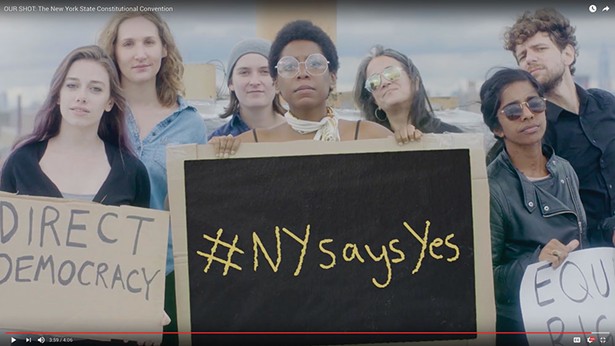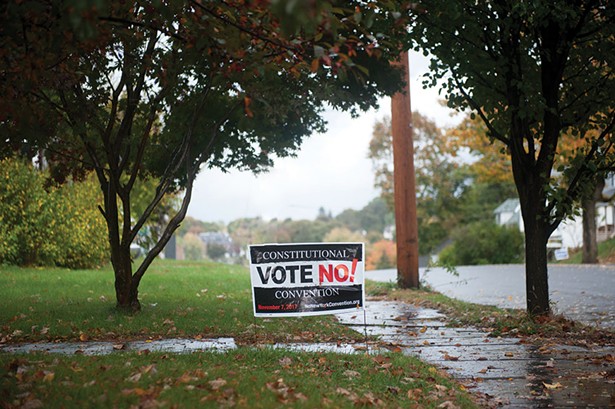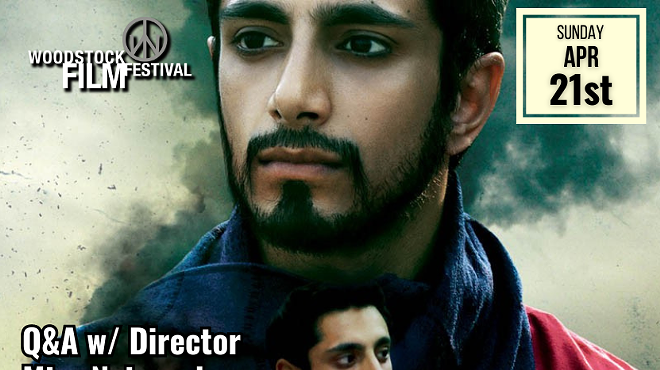The last time New Yorkers held a state constitutional convention, in 1967, Gerry Benjamin was in graduate school for political science at Columbia University. He studied the deliberations from afar, and considered the resulting proposals, which were ultimately rejected by the voters. The state wouldn't assume Medicaid costs, nor create neutral redistricting and disallow gerrymandering—just two of the ideas that never came to pass. "I've got a list of about 30 or 40 items in my file of good ideas that weren't adopted in '67," says Professor Benjamin, who is the director of the Benjamin Center for Public Policy Initiatives at SUNY New Paltz, and an acknowledged expert on New York State and local government. For several months, he's been speaking all over the Hudson Valley about the question that they'll face on November 7 in the voting booths: Shall New York hold a convention to revise the constitution and amend the same?
If the majority votes yes, then the Constitutional Convention machinery starts rolling. First, voters would elect a total of 204 convention delegates in 2018. There will be three delegates from each of the 63 state Senate districts and 15 others who are elected statewide. Candidates would run just like they would for any other office, and anyone can run for a delegate seat. In April of 2019, the delegates would meet in Albany for a convention lasting four to six months, resulting in a draft package of amendments to put to the voters that November.
If the majority this November marks no, then nothing happens. And therein lies the controversy.
A Vigorous Debate
Organized campaigns on both sides of the question have formed, and they're raising funds and running ads. A convention is favored mostly by good government advocates, like Benjamin, who believe in empowering the democratic systems and processes our political forbears established. Funded predominantly by individual donors, the good government groups believe that a 2019 constitutional convention can take our 19th-century document into the 21st century. According to a NYPeoplesConvention ad, the New York constitution was last substantially revised in 1938 at a convention that included only six women and two black men among the 186-person delegation. Revising the constitution now, they assert, with a delegation representative of New York's diversity, could elevate the rights of women and people of color, who have been historically less protected by the state constitution.
"There really are no certainties whatsoever as to what could emerge from a constitutional convention," says Fred Kowal, President of the United University Professionals (UUP). "Once they meet at the convention, literally the entire document is open to changes, and there are no restrictions as to how far they could go in changing the constitution."
For the UUP, local labor chapters, and teachers' unions, protection of public education and workers' rights are key. "The huge amount of money that goes to candidates who support charter schools, certainly that kind of money's going to flow in to support the election of delegates who would try to change those provisions and create protections in the constitution for charter schools, which would undermine public schools," Kowal says. He also details a national movement against collectively bargaining. "We are also concerned, obviously, that the Koch brothers, who have hundreds of billions of dollars to spend, will see a constitutional convention as the time when they could come and turn New York State into a right-to-work state."

"It's a situation in which, unfortunately, scare tactics are being used—by some of the unions, especially, to tell falsehoods about pensions for existing public employees and retirees being at risk," says Henrik Dullea, a SUNY trustee and good government advocate who was on the floor of the 1967 convention and wrote a history of the convention, Charter Revision in the Empire State: The Politics of New York's 1967 Constitutional Convention (1997). He says that the teachers' and public employee unions are major lobbying organizations that appear to be contributing the most to the no vote campaign.
POLITICO New York investigated the spending of more than 200 individuals and organizations taking a position on the convention. Looking at lobbying activity and state elections, including candidate, party, and super PAC funding, they found that convention opponents outspent proponents $24.2 million to $389,000. Opposing concerns center around losses of current constitutional protections.
At What Cost?
Opening day in the chamber of the 1967 New York State constitutional convention was exciting, according to Dullea. Addresses were given by Supreme Court Chief Justice Earl Warren, Governor Nelson Rockefeller, and Senators Jacob Javits and Robert F. Kennedy. The floor debates were spirited and lengthy. Ultimately, the delegation significantly edited and reshaped the constitution. "They saw it as an integrated document," Dullea says, so the delegates submitted a single package to the voters for approval, as opposed to packaging proposals into multiple ballot questions. "Some Democrats thought that the popular things would outweigh the controversial things." Things like the Blaine Amendment.
Added in 1894 to prohibit state funding to religious schools, the Blaine Amendment was later changed to allow state-funded transportation and ancillary (not direct classroom) services for religious school students. Repeal of the Blaine Amendment was approved by the 1967 delegates. "In the end, it was one of the reasons many people voted against the newly submitted constitution," Dullea says.
The cost of a convention has been an integral part of the debate. A 1973 book by the League of Women Voters put the 1967 convention cost at almost $11 million, and Dullea estimates it ran no more than $15 million. Adjusting for inflation, current estimates run from $50 to 100 million.
"Regardless of whether it's $50 million or $300 million, or anywhere in between, it's still a lot of money," says Republican Senator George Amedore of the 46th Senate District in the Hudson Valley. Like most elected officials in the state, Amedore opposes a constitutional convention. "I know of infrastructure projects that need to be funded. I know of services that need to be rendered. The governor may be calling us back shortly into special session to address budget deficits." The Senator points out that any project in the state of New York can have cost overruns, and a convention is not necessary because amendments to the state constitution can be made through the legislature. After being proposed and deliberated upon, amendments must be passed by two consecutively elected legislatures, and put to voters for final approval. Convention opponents say it's a system that's been used successfully 200 times since 1894.
In fact, on this year's ballot, there will be two constitutional amendments alongside the constitutional convention question: pension forfeiture for elected officials found guilty of a crime and the creation of a state-owned land bank in the Adirondacks.
Senator Amedore says it's a good demonstration of the legislative process. "It's not easy to get a constitutional amendment on the ballot because of all the work and time it takes," he says. There are 64 members of the Senate and 150 members of the Assembly, all with varying ideologies and constituencies. "Think about all the work that we've done as legislators, and the governor then backed it up by signing it. It's a process that is cumbersome, but it works. It's well thought out, and it happens in a way that's transparent."
"It's a long process. It's not easy to do a constitutional amendment, and it shouldn't be easy," says Jennifer Wilson, Program and Policy Director for the League of Women Voters of New York State, which supports a yes vote. "The biggest problem has been the gridlock in Albany," she says. The League has their sights set on voter reform. "We've been lobbying for these reforms; [the legislature] has done nothing." Difficulty in voter registration is often cited as cause for New York's low voter turnout and enrollment, so the League would like the requirement for absentee ballot justification dropped, party registration deadlines changed, and to block legislators from appointing members to redistricting commissions. "Legislators should not be picking the people who draw their district lines," Wilson says.
A Half Billion Wasted
One of Professor Benjamin's signature achievements was leading the process for adopting an Ulster County charter. Between 1981 and 1993, he served in legislative leadership as both Majority Leader and Chairman, the highest position at a time when Ulster County had no elected executive. On July 13, at an educational forum presented by KingstonCitizens.org at the Public Library, Benjamin said, "It's a massive problem that people don't understand their charters." It's empowering when people learn, he continued, that they can change the fundamentals of their government. The county charter he worked on has a requirement for regular reassessment by a Revision Commission every 10 years.
"New York suffers from disabilities in its governance, and increased costs, reduced democracy, and institutional stasis, partly as a consequence of its constitution," Benjamin explains. "So, we need to make some reforms that are pretty fundamental." Benjamin doesn't think that the state legislature is willing, through the legislative amendment process, to change the way it's elected, enhance voter participation, or impose stringent ethics processes on themselves. (Since 2000, 33 legislators have been indicted for criminal or ethical violations.)
In 1993, Governor Mario Cuomo tapped Benjamin to be research director of the Constitutional Revision Commission in anticipation of the 1997 constitutional convention ballot question. The Commission called for four action panels to be formed by the legislature, but they weren't.
"This used to be routine. Every 20 years, they'd gather and say, 'We can make things better.' They believed in themselves in the 19th century," Benjamin says. For Benjamin, it's a hope-versus-fear campaign. The New York State Bar Association agrees. Their House of Delegates met in Cooperstown in June and voted 111 to 28 in favor of a recommendation to support the ballot question. In presenting the Committee's findings, Chair Hank Greenberg noted that the New York State constitution is a 52,500-word behemoth. "The document was not designed to last through the ages," he told the audience of lawyers.
Ultimately, the Bar Association concluded that the need to reform the judiciary article in the state constitution was long overdue. Overlapping jurisdictions with varying rules and procedures results in an estimated $600 million wasted every year. The State Bar, along with individual justices, have made the case for judicial reform; yet, in 50 years, the legislature hasn't acted. "As a committee, we deeply believe that the risks are overstated," Greenberg said. Historically, the nine previous constitutional conventions were progressive rather than regressive, he noted. "This is a once-in-a-generation opportunity—a rare chance for direct democracy."
Deliberation Delegation
Benjamin doesn't believe that people who want to reform the state government at a convention would touch the current protections people cherish because that would just mobilize voters against the revisions in 2019. "The changes we propose under the process have to be ratified at the polls after they're recommended by a convention," he explains. "So, would I, or anybody who's interested in reform, put my reforms at risk by trying to change valued provisions? I would say not."
Convention delegates run for the office with all the trappings of a campaign. There are no constitutional amendments to bar elected officials from being delegates, nor prohibiting them from collecting a second salary or pension credit (called double-dipping). Because of that, Anthony Figliola, half of the bipartisan duo who leads Empire Government Strategies, a lobbying and consulting firm, insists a convention now would be in the best interest of politicians, not the people.
"I know that the good-government people believe in this utopian society," Figliola says. "They're under the delusion that if they can convince the majority of people to vote, then Joe six-pack will be a delegate. That's a false hope and disingenuous." Figliola thinks it would take a lot of resources to run.
Dullea wouldn't speculate on how much a delegate campaign might cost now, but he interviewed some back in 1967: very little was spent on delegate races, and candidates personally funded them. Depending on the circumstances of the district, some upstate Republicans felt assured that their constituents would vote down party lines. In Democratic races in the Bronx, candidates pooled resources with other party candidates running for Assembly and Senate seats. A contested race in Nassau County resulted in one wealthy candidate spending $9,000 of his own money.
Because the Supreme Court's 2010 Citizens United ruling allows large sums from corporations, nonprofits, labor unions, and associations to finance campaigns, Figliola and others are concerned about special interests from outside the state unduly influencing a New York convention.
A Chance to Hit Restart
At an October 16 debate between Benjamin and the UUP's Kowal at SUNY New Paltz, Kowal stated that a constitutional convention now is a distraction from more pressing national concerns. "What is really needed to address some of the problems is a national progressive movement to deal with issues like health care, workers' rights across the country, economic justice, racial justice, protection of the environment." Kowal argued that New York might focus too narrowly on reforming the state constitution and end up damaged by decisions in Washington. "We really can't take our eye off that ball."
Benjamin sees the large-scale democratic mobilization happening nationally as good reason for protecting ourselves from whatever happens nationally by asserting our values in the state constitution. At age 73, having watched this debate for five decades, Benjamin is convinced of the need to confirm our commitment to democratic representation. "I think it's symbolically and socially important," says Benjamin. "We can create a moment where we're giving a thorough review to a system that has performed marginally for a long time. We can restart New York."
Whether we vote to give New York a restart or leave the constitution unchanged will be decided at the polls on November 7.












